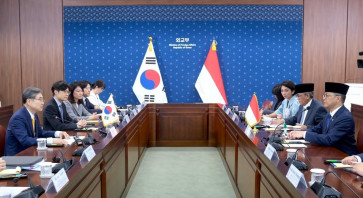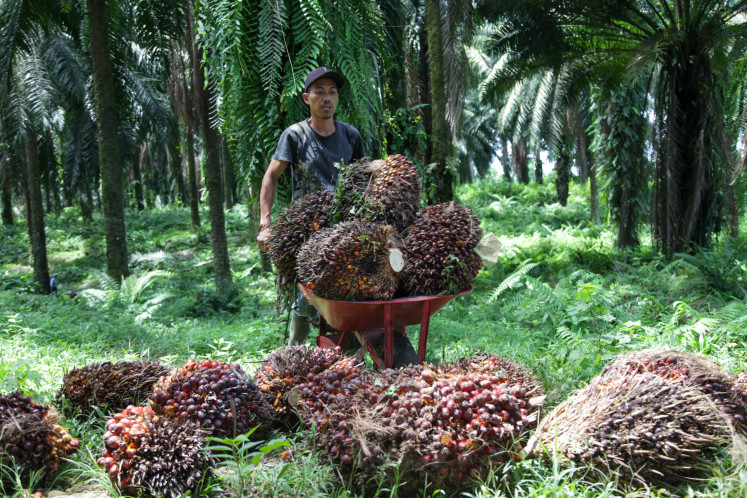Popular Reads
Top Results
Can't find what you're looking for?
View all search resultsPopular Reads
Top Results
Can't find what you're looking for?
View all search resultsSBY economic legacy will cloud Jokowi's prospects
Palm turf: Oil palm plantations in Riau are seen from the air on April 3
Change text size
Gift Premium Articles
to Anyone
P
span class="caption" style="width: 595px;">Palm turf: Oil palm plantations in Riau are seen from the air on April 3. The commodity boom during 2003-2011 fueled Indonesian economic growth, but when it ended in 2012, the manufacturing sector was not ready to take over the driving seat. (Antara/FB Anggoro)
The growing inequality is the most visible negative product of economic growth during SBY's tenure.
Over the course of Susilo Bambang Yudhoyono's (SBY) decade-long presidency, Indonesia has enjoyed one of the highest economic growth rates in the world. It has raised the income and welfare of Indonesians, created jobs for 18 million people and lifted 7 million people out of poverty.
Annual economic growth during the first term of SBY's presidency in 2005-2009 was 5.6 percent. In the second term, annual growth was up to 6 percent. Income per capita in rupiah nominal terms has gone up from Rp 10 million (US$1,000) in 2003 to
Rp 36.5 million ($3,100) in 2013 according to the Central Statistics Agency (BPS).
In terms of US dollars per capita gross domestic product (GDP) grew 14.6 percent in each year of SBY's first term between 2005 and 2009. In his second term from 2009 to 2013, annual growth in per capita GDP slowed down to 10.2 percent. This was because in 2012 the per capita GDP in US dollars only grew 2 percent, but in 2013 it contracted by 3 percent to $3,468, reflecting the significant slowdown of the overall economy and the steep depreciation of the rupiah during those years.
The high economic growth during the decade has strengthened the government's fiscal stance, enabling the government to reduce debt financing in its budget. As a percentage of GDP, government debts have fallen from 47 percent in 2005 to 22.1 percent in 2013. Over the decade, there has been a shift in the composition of government debt, as government relies more on issuing rupiah denominated bonds in the Jakarta capital market to finance its budget deficits. Foreign debt fell from 46 percent of total debt in 2005 to 30 percent in 2013. This strategy has reduced the state budget's vulnerability to foreign exchange risk.
The annual economic growth was maintained at 5-6 percent despite the 2008 financial crisis, volatilities and shocks in the global economy during the last decade. Indonesia could weather relatively well the impact of the global economic crisis in 2008-2009. The world economy plunged into recession, but the Indonesian economy only experienced a drop in growth from 6.1 percent to 4.5 percent in 2008-2009. By contrast, neighboring countries Thailand and Malaysia suffered contractions in their economic growth by 2.3 and 1.5 percent respectively
In the aftermath of the global financial crisis, the Indonesian economy grew strongly over the next two years, reaching its peak in 2011, when growth reached 6.5 percent, the highest level since the Asian economic crisis in 1997-1998. This was the time when China's and India's economies grew by more than 10 percent, pushing up their demand for Indonesian commodity exports.
But from 2011 onward, Indonesian growth weakened, largely from the weakening performance of the manufacturing and service sectors. On the demand side, although the growth of private consumption continued to be robust, investment and net exports fell significantly.
Indonesia's growth was driven by a commodity boom during 2003-2011 period and supported by low global interest rates and Bank Indonesia's pro-growth monetary policy. These factors supported corporate earnings, household income and raised domestic demand to propel overall economic growth. But since 2011, commodity prices have softened significantly. In addition, the US Federal Reserve's quantitative-easing policy ' which led to lower global interest rates ' is being gradually unwound, increasing financing costs with negative implications for investment. As these external supports fade, it will be difficult for Indonesia to generate the growth seen in 2007-2012.
Foreign Direct Investment (FDI), after a spurt in 2009-2011, began to decline, from $19.2 billion in 2011 to $19.1 billion in 2012 and to $18.8 billion in 2013. The decline in growth is consistent with the overall investment growth in the GDP. The decline of the FDI growth will likely continue in 2014, due to various obstacles.
The slowing down of economic growth in the second term of SBY's tenure has impacted employment growth, poverty reduction and income inequality.
Indonesia has made a significant progress alleviating poverty. The number of persons living below the poverty line has fallen from 16 percent in 2005 to 11.4 percent in 2013. During the 10 years of Yudhoyono presidency, a total of 7 million people were lifted out of poverty. But due to slower economic growth and the impact of price increases for subsidized fuel in 2013, the declining trend of poverty has reversed. Between March 2013 and September 2013, the number of people living below the poverty line rose to 28.55 million, meaning some 500,000 persons have become poor.
Although the poverty level has declined, the figures mask huge variations in poverty levels among regions. Two comparatively prosperous provinces, Jakarta and Bali, have poverty level below 3.7 percent, well below the national average. Provinces rich in natural resources, such as Eastern Kalimantan, Riau, Jambi and Bangka Belitung have poverty levels at 5-8 percent, still below national average. The most glaring poverty exists in Papua and West Papua, where the rate has remained at 30 percent for several years.
The problems of poverty also relates to the problems of raising the living standard of those people who are 'near poor', or on the verge of absolute poverty. These are the people whose income is vulnerable to crisis and economic shocks who could easily slip into poverty.
Despite rising wealth and the reduction in poverty, the gap between the rich and the poor has widened during the SBY presidency. The growing inequality is the most visible negative product of economic growth during this period. Data indicates that Indonesian economic growth during the last decade has mostly benefitted the rich. According to the World Bank, in 2002 the average consumption per person among the richest 10 percent of households was 6.6 times that of the poorest 10 percent. By 2013 this ratio had risen to 10.3 times. The Gini coefficient, which measures inequality, climbed from 0.30 percent in 2000 to 0.42 by 2013. A higher Gini ratio means higher inequality in income.
Several factors have been responsible for these outcomes. Globalization has resulted in the widening gap between the wages of the skilled and the unskilled. The pattern of fiscal spending has been unfavorable to the poor, as some spending gives more benefits to the rich than to the poor, such as the fuel subsidy and infrastructure developments, which are concentrated in urban areas. Increasing inequality could slow down the rate of poverty reduction. It is no wonder, then, that the slowdown in the reduction of poverty rate of late coincides with increasing income inequality.
During the SBY presidency, the economy created 8 million jobs. As more and more people found work, unemployment fell from 11.2 percent in 2005 to 6.1 percent in 2012, although in 2013 it inched back up to 6.3 percent due to slower economic growth. However, most of the jobs created were in sectors of low productivity and with low wages. Around 60 percent of workers worked in the informal sector, where wages are lower than in the formal sector, and which carry no job protection or health care benefits. The stringent requirements laid out in the 2003 Labor Law has discouraged corporations from employing more workers; instead they have used more high-tech machines that reduce labor needs.
The decade-long SBY presidency failed to eliminate the fuel subsidy by bringing domestic fuel prices in line with international prices. The problem of fuel subsidies has instead been dealt with through sporadic price increases and decreases, depending upon the level of political opposition. Substituting kerosene with 3-kilogram canisters of liquefied petroleum gas (LPG) has been implemented, reducing the kerosene subsidy substantially. Quantitative restriction has been attempted recently in greater Jakarta by introducing a cap on consumption of the subsidized fuel. But this ad hoc approach is no substitute for a permanent solution for the wasteful subsidy spending.
During the SBY presidency, oil production dropped from 346.3 million barrels in 2009 to 301.4 million barrels in 2013, a decline of 3 percent each year. Current oil production is concentrated in existing wells that mostly are old and less producing less. There have not been any major oil discoveries in recent years except for the Cepu block in Central Java. Oil companies are still reluctant to commit money for oil exploration, especially in remote areas where the cost, risk, and complexities are high. Every year, the government offers several oil blocks for tender, but only a view are taken by oil companies. Legal uncertainties in licensing, taxation, and cost-recovery mechanisms remain confusing, a fact that discourages oil companies from investing money for oil exploration.
Despite efforts at diversifying energy use, dependency on fossil fuels rose from 64.7 percent in 2007 to 66.4 percent in 2011. Conversion from the use of oil into gas is being hampered by the delay of construction of infrastructure for transporting gas. While fossil fuel reserves are being depleted rapidly, the development of alternative energy remains stagnant.
The SBY administration has not been able to lift the economy out of its dependence on commodity exports. The commodity boom has encouraged more investment in natural resource-based industries, while non-commodity manufacturing sector growth remained weak. Growth in that sector was only half of what it was prior to the Asian economic crisis in 1997-1998. So when the commodity boom ended in 2012, the manufacturing sector was not yet in a position to replace commodity exports as a driver of economic growth.
The Joko 'Jokowi' Widodo presidency will face an evolving global environment where the tailwinds of the past decade ' rising commodity prices and low global financing costs ' have slowed. He will face continuing pressure in his fiscal outlook unless he is determined to pursue fuel subsidy and tax reforms.
If he wants to spur economic growth to reach his goal of 7 percent, then he has to be able to revive investment, especially investment in manufacturing sectors. Boosting investment means a readiness to make the Indonesian economy more open to investment and trade. This is the only way to strengthen the productivity and competitiveness of the Indonesian economy. But these might go against the populist and nationalistic character of his mission and vision as laid out in his campaign. That is why in formulating policies, some trade-off between staying principled and acting pragmatically cannot be avoided.
The most difficult aspect of policymaking for president-elect Jokowi will be to reach political consensus to introduce reforms. Democratization and decentralization have fundamentally changed accountability structures and the decisionmaking process within the government. The task of reaching consensus on critical policies and reforms has become more challenging because highly competitive elections have led to coalition politics at the national level as well as at regional levels. Non-state actors have also acquired more voice in the political arena, creating more complexities in policymaking.
If president-elect Jokowi can mobilize more support for his coalition parties, he should not squander his strengthened political capital; he should use that support to introduce bold economic reforms that move the economy forward. However, economic reforms require political leadership and a strong team in order to be executed effectively. That is why Jokowi needs to recruit and appoint people in his Cabinet and other state institutions who understand the necessity of reforms and who will be willing to implement them.










